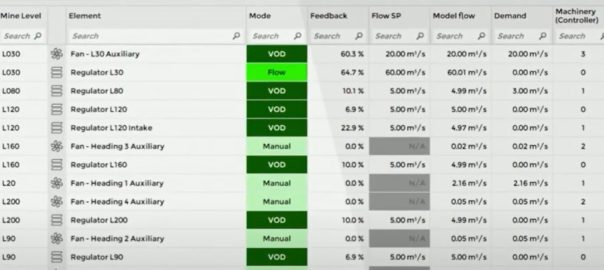Ventilation solutions provider, Howden, says it is continuing to register strong demand for ventilation on demand (VoD) solutions from the mining sector, on continual cost control measures, improved safety requirements and the evolving need to chart emissions underground.
The company recently added Cooling on Demand (CoD) functionality to its Ventsim CONTROL software, which reflects this market demand.
Ventsim CONTROL uses intelligent software connected to Howden or third-party hardware devices to remotely monitor, control and automate airflow heating and cooling to deliver safer, more productive, and lower cost ventilation for mines, the company says. The Ventsim CONTROL solution also offers a 3D modelling capability within the software, which helps users to better predict and control air flows based on what is evidenced in the simulation.
In the case of CoD, this means users can monitor temperatures at deeper levels and push back cooled air more efficiently.
Upon release of the solution last year, Howden said the CoD update aligned with trends it was seeing in the industry towards deeper mines requiring cooled air to achieve higher standards of health and safety for workers.
“Currently, many mines put a cooling plant at surface level and cool air regardless of its destination or where it’s needed as there aren’t intelligent controls to pinpoint the localised need, which is often at deeper levels,” Howden said. “These new controls ensure the cool air goes where it is required, saving operating and energy costs.”
The company is currently in the process of lining up a trial of this new functionality with an existing Ventsim CONTROL customer.
Howden has also won several Ventsim CONTROL contracts across the globe, including in South America, Asia Pacific and Europe, of late.
Jose Pinedo, Ventsim Sales Manager, said most of these contracts reflected the mining sector’s ongoing focus on cost control, as well as those ‘net-zero’ commitments.
“All the different sites had a payback target in mind, but some of the sites also wanted to know what the implementation of the system would do for their CO2 emissions,” he told IM.
Within Ventsim CONTROL, there is an in-built energy reporting tool to show clients their ongoing energy consumption. Following customer requests and in-house development work, Howden has been able to adapt this to generate a rolling CO2 emission indicator that clients can monitor.
“The reduction in energy correlates directly to a reduction in tonnes of CO2 emissions,” Pinedo said of the reporting tool. “This means, in addition to what the system will provide in operational terms and operating costs, it can also outline to clients how it will assist them in meeting environmental goals.”
Leo Botha, Ventsim General Manager, said the ability for Ventsim CONTROL to reduce the energy consumption associated with ventilation and the direct correlation between these savings and CO2 emission reductions is allowing Howden to assist miners in hitting their environmental goals.
“Up front, when you are having the discussion and talking to mines about energy savings, you are also directly talking about CO2 emission reductions and how this can be used in ESG reporting,” he said.
This increased carbon emission visibility, plus expectations of stricter regulations in key mining jurisdictions, is likely to lead more clients towards the use of VoD solutions, according to Pinedo.
“For instance, with Australia adopting stricter diesel particulate emissions, the industry is facing two options in terms of keeping up with legislation: either you retrofit your fleet so you’re running more efficient and ‘cleaner’ diesel engines (US Tier 4 F/EU Stage V) or electric equipment, or you increase your ventilation flow to meet the new emission requirements,” he said.
Even if a mine chose Option A – retrofitting their fleet – the ventilation flow requirements may still need to increase, Pinedo explained.
“Without a VoD system, you must have a ventilation system set up based on the required air for x number of vehicles and personnel, regardless of if they are operating at all times,” he said.
A VoD system, however, allows mines to push air only to where it is needed based on the vehicles, personnel and infrastructure in place and operating at that given time.
With more mixed fleets of mobile mining equipment expected in the future made up of battery-electric, hybrids and diesel-powered equipment, the benefits of a VoD system able to tap into existing infrastructure for telematics and positioning will be highlighted further, enabling mines to ventilate based on the type of engine/battery the machine is powered by and if there is an operator in the cab.
“What we’re offering through Ventsim CONTROL is to use all these existing tools and optimise everything to comply with where legislation is heading and the evolution of ‘net zero’ mining,” Pinedo said.
The operation, having already installed Ventsim CONTROL Level 3 (scheduling and flow control), is progressing to an installation that will see the mine’s tracking system integrated to Ventsim CONTROL Level 4. This will provide real-time feedback on the vehicle locations in Ventsim CONTROL to adjust the ventilation automatically based on demand.
Ventsim CONTROL software also continues to gain appreciation from customers for its safety capabilities.
“One of the features we have in Ventsim CONTROL is related to fire simulation,” Pinedo said. “We also have this in our Ventsim DESIGN software with scenario-based simulations, but the facility on Ventsim CONTROL connects to all your communication infrastructure underground to take an instant snapshot of the status as a fire is happening.
“From a planning point of view, this allows operations to have a much quicker response time based on an accurate, real-time picture of what is going on underground. This provides another tool to allow them to take the right decisions when and if needed.”








